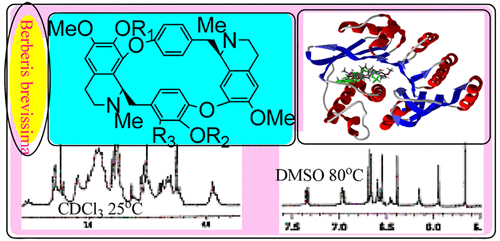当前位置:
X-MOL 学术
›
J. Nat. Prod.
›
论文详情
Our official English website, www.x-mol.net, welcomes your feedback! (Note: you will need to create a separate account there.)
Effect of Temperature on 1H NMR Spectra, Antitrypanosomal Activity, Conformational Analysis, and Molecular Docking of Curine Derivatives from Berberis brevissima.
Journal of Natural Products ( IF 5.1 ) Pub Date : 2020-05-04 , DOI: 10.1021/acs.jnatprod.9b00397 Saqib Ali 1 , Muhammad Alamzeb 1 , Mamoon Ur Rashid 2 , William N Setzer 3
Journal of Natural Products ( IF 5.1 ) Pub Date : 2020-05-04 , DOI: 10.1021/acs.jnatprod.9b00397 Saqib Ali 1 , Muhammad Alamzeb 1 , Mamoon Ur Rashid 2 , William N Setzer 3
Affiliation

|
The ethanolic root extract of Berberis brevissima afforded a new bisbenzylisoquinoline alkaloid, 13-nitrochondrofoline (2), and two known bisbenzylisoquinoline alkaloids, chondrofoline (1) and curine (4). The acetylation of chondrofoline (1) gave O-acetylchondrofoline (3). The dimeric structures of 1 and 2 were studied through variable-temperature 1H NMR spectroscopy at 25, 40, 60, and 80 °C and conformational analysis, using density functional theory employing the M06-2X functional and the 6-31G* basis set. The in vitro antitrypanosomal activity of compounds 1, 2, 3, and 4 against Trypanosoma brucei showed significant potential with MIC values of 2.6, 2.2, 2.3, and 3.8 μM, respectively. Molecular docking evaluation of alkaloids 1, 2, 3, and 4 against known T. brucei protein targets revealed T. brucei phosphodiesterase B1 to be the preferred target. The docking energies of the alkaloids with Tb6PGL (PDB 3EB9) ranged from -88.8 to -106.0 kJ/mol and was comparable to the cocrystallized ligand, citrate (Edock = -78.3 kJ/mol). It seems reasonable that the curine alkaloids may compete with the natural substrates for these protein targets and serve as leads in designing and developing more potent and selective drugs against T. brucei.
中文翻译:

温度对小Ber小Cur碱衍生物的1H NMR光谱,抗胰酶活性,构象分析和分子对接的影响。
小ber的乙醇根提取物提供了一种新的双苄基异喹啉生物碱13-硝基软骨素(2)和两种已知的双苄基异喹啉生物碱,软骨素(1)和姜黄素(4)。软骨素(1)的乙酰化得到O-乙酰软骨素(3)。使用密度泛函理论(采用M06-2X官能团和6-31G *基组),通过在25、40、60和80°C下通过变温1H NMR光谱和构象分析研究了1和2的二聚体结构。化合物1、2、3和4对布鲁氏锥虫的体外抗锥虫活性显示出显着的潜力,MIC值分别为2.6、2.2、2.3和3.8μM。分子对接生物碱1、2、3和4对已知的布鲁氏杆菌蛋白靶标的评估显示了T。布氏磷酸二酯酶B1是首选靶标。生物碱与Tb6PGL(PDB 3EB9)的对接能范围为-88.8至-106.0 kJ / mol,可与共结晶的配体柠檬酸盐(Edock = -78.3 kJ / mol)相媲美。姜黄素生物碱可以与天然底物竞争这些蛋白质靶标,并在设计和开发针对布鲁氏杆菌的更有效和选择性的药物中起领先作用,这似乎是合理的。
更新日期:2020-05-04
中文翻译:

温度对小Ber小Cur碱衍生物的1H NMR光谱,抗胰酶活性,构象分析和分子对接的影响。
小ber的乙醇根提取物提供了一种新的双苄基异喹啉生物碱13-硝基软骨素(2)和两种已知的双苄基异喹啉生物碱,软骨素(1)和姜黄素(4)。软骨素(1)的乙酰化得到O-乙酰软骨素(3)。使用密度泛函理论(采用M06-2X官能团和6-31G *基组),通过在25、40、60和80°C下通过变温1H NMR光谱和构象分析研究了1和2的二聚体结构。化合物1、2、3和4对布鲁氏锥虫的体外抗锥虫活性显示出显着的潜力,MIC值分别为2.6、2.2、2.3和3.8μM。分子对接生物碱1、2、3和4对已知的布鲁氏杆菌蛋白靶标的评估显示了T。布氏磷酸二酯酶B1是首选靶标。生物碱与Tb6PGL(PDB 3EB9)的对接能范围为-88.8至-106.0 kJ / mol,可与共结晶的配体柠檬酸盐(Edock = -78.3 kJ / mol)相媲美。姜黄素生物碱可以与天然底物竞争这些蛋白质靶标,并在设计和开发针对布鲁氏杆菌的更有效和选择性的药物中起领先作用,这似乎是合理的。



























 京公网安备 11010802027423号
京公网安备 11010802027423号